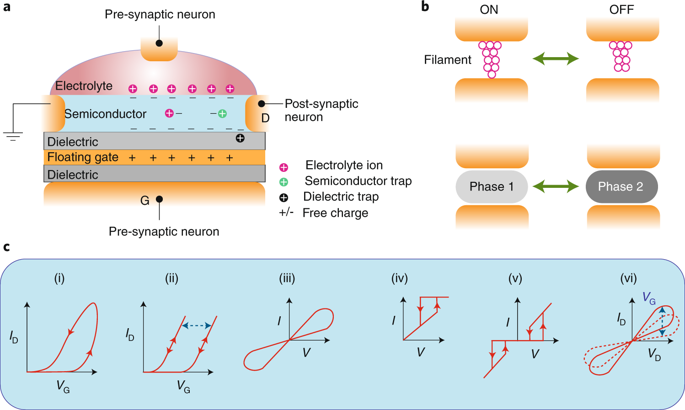当前位置:
X-MOL 学术
›
Nat. Nanotechnol.
›
论文详情
Our official English website, www.x-mol.net, welcomes your feedback! (Note: you will need to create a separate account there.)
Neuromorphic nanoelectronic materials.
Nature Nanotechnology ( IF 38.3 ) Pub Date : 2020-03-02 , DOI: 10.1038/s41565-020-0647-z Vinod K Sangwan 1 , Mark C Hersam 1, 2, 3
Nature Nanotechnology ( IF 38.3 ) Pub Date : 2020-03-02 , DOI: 10.1038/s41565-020-0647-z Vinod K Sangwan 1 , Mark C Hersam 1, 2, 3
Affiliation

|
Memristive and nanoionic devices have recently emerged as leading candidates for neuromorphic computing architectures. While top-down fabrication based on conventional bulk materials has enabled many early neuromorphic devices and circuits, bottom-up approaches based on low-dimensional nanomaterials have shown novel device functionality that often better mimics a biological neuron. In addition, the chemical, structural and compositional tunability of low-dimensional nanomaterials coupled with the permutational flexibility enabled by van der Waals heterostructures offers significant opportunities for artificial neural networks. In this Review, we present a critical survey of emerging neuromorphic devices and architectures enabled by quantum dots, metal nanoparticles, polymers, nanotubes, nanowires, two-dimensional layered materials and van der Waals heterojunctions with a particular emphasis on bio-inspired device responses that are uniquely enabled by low-dimensional topology, quantum confinement and interfaces. We also provide a forward-looking perspective on the opportunities and challenges of neuromorphic nanoelectronic materials in comparison with more mature technologies based on traditional bulk electronic materials.
中文翻译:

神经形态纳米电子材料。
忆阻和纳米离子设备最近成为神经形态计算体系结构的主要候选对象。虽然基于常规块状材料的自上而下的制造已使许多早期的神经形态设备和电路成为可能,但基于低维纳米材料的自下而上的方法却显示出新颖的设备功能,通常可以更好地模仿生物神经元。此外,低维纳米材料的化学,结构和组成可调性以及范德华异质结构所带来的排列灵活性为人工神经网络提供了重大机遇。在这篇评论中,我们对由量子点,金属纳米颗粒,聚合物,纳米管,纳米线,二维层状材料和范德华异质结,特别强调生物启发的设备响应,这些响应通过低维拓扑,量子限制和界面而独特地实现。与基于传统体电子材料的更成熟技术相比,我们还提供了关于神经形态纳米电子材料的机遇和挑战的前瞻性观点。
更新日期:2020-03-02
中文翻译:

神经形态纳米电子材料。
忆阻和纳米离子设备最近成为神经形态计算体系结构的主要候选对象。虽然基于常规块状材料的自上而下的制造已使许多早期的神经形态设备和电路成为可能,但基于低维纳米材料的自下而上的方法却显示出新颖的设备功能,通常可以更好地模仿生物神经元。此外,低维纳米材料的化学,结构和组成可调性以及范德华异质结构所带来的排列灵活性为人工神经网络提供了重大机遇。在这篇评论中,我们对由量子点,金属纳米颗粒,聚合物,纳米管,纳米线,二维层状材料和范德华异质结,特别强调生物启发的设备响应,这些响应通过低维拓扑,量子限制和界面而独特地实现。与基于传统体电子材料的更成熟技术相比,我们还提供了关于神经形态纳米电子材料的机遇和挑战的前瞻性观点。



























 京公网安备 11010802027423号
京公网安备 11010802027423号